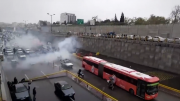As the treacherous swirls of the multi-sided fighting in Syria keep sinking hopes of relief for its brutalised people, signs are emerging that Iran — whose support for President Bashar al-Assad in the past five years has kept his regime afloat — is looking seriously at a political solution to the conflict.
Mohammad Javad Zarif, the foreign minister who negotiated last year’s nuclear deal between Iran and world powers, met John Kerry, US secretary of state, on the sidelines of an annual peace negotiators’ forum in Oslo last week, apparently indicating that Tehran is willing to be more flexible on formulas to end the war.
This coincides with a shake-up in Tehran, where Mr Zarif has replaced his deputy with someone amenable to dialogue. Ali Shamkhani, head of the Supreme National Security Council, has been made Iran’s point man on Syria.
While it is always risky to overinterpret reshuffles inside an opaque system ultimately governed by Ayatollah Ali Khamenei, the supreme leader, these developments nevertheless suggest less influence for the Islamic Revolutionary Guard Corps, which has made the running so far on Syria.
Mr Shamkhani, for instance, a former navy chief and IRGC leader, is an ethnic Arab associated with Iran’s political centre. He was defence minister through both terms of the reformist president Mohammad Khatami from 1997 to 2005, and was appointed security chief by Hassan Rouhani, the centrist president behind the nuclear deal.
Given the skill and strategic patience with which Iran negotiated that accord, the present flurry of signalling may have aims beyond Syria. The Islamic Republic accepted curbs on its nuclear programme in return for sanctions relief for its economy, only to find that “secondary sanctions” — aimed mainly at the IRGC and its expeditionary forces across the region — are still inhibiting investment in and credit for Iran. It is unlikely it would move on Syria while its economy remains cut off from the US banking system as well as from international banks that fear being shut out if they engage with Iran.
Even so, as the fighting in Syria rages, both of the Assad regime’s external patrons, Russia and Iran, appear to be thinking about the country’s future. That discussion has been blocked by western insistence that Mr Assad and his blood-soaked clan must go, while Moscow and Tehran insist he still has legitimacy — and both sides fear his departure could leave a vacuum for the jihadis of Isis and al-Qaeda.
The Assad regime’s depleted army increasingly exists only on paper, while its allies are sustaining heavy and rising casualties
Russian officials have intimated they are looking at a new constitution for Syria, while Iran is indicating that replacing the iron centralism of a minority regime with a looser federal model may be the way forward.
“The answer is to focus on institutional dispersion of power and the future form of governance, through which you may be able to reduce or even eliminate the centrality of the role of any individual or ethnicity,” Mr Zarif told Al-Monitor, a website covering the Middle East.
That sounds vague while the Assad regime continues to rain down barrel bombs on rebel enclaves. What gives it possible substance is the growing amount that Iran and Russia are paying for their support.
First, the Syrian enterprise is costly for both countries, which are already hurting from low oil prices and economic sanctions. Putting a figure on this is tricky but Arab security sources say Syria cost Iran $600m-$800m a month in 2013-14.
Second, this level of backing to the Assads against Syria’s Sunni majority risks incurring the enmity of the Sunni for generations. Russia has about 25m Sunni inside its borders and Isis is establishing a foothold in the southern Caucasus. Iran’s influence, based on the Shia axis it has built from Baghdad to Beirut, cannot be sustained at its current level, except at the cost of continuing war. This would further aggrandise the IRGC internally and prevent Iran from winning legitimacy in the region and re-entry to world markets and institutions.
These factors may not weigh enough against President Vladimir Putin’s ambition to re-establish Russia as a superpower able to challenge the US and Europe, or against the desire of some factions in Tehran to lead the world of Shia Islam and challenge the far more numerous Sunni. But a third consideration is hard to dismiss: numbers.
The Assad regime’s depleted army increasingly exists only on paper, while the IRGC, its Hizbollah paramilitary allies from Lebanon, Iraqi Shia militia and Afghan auxiliaries pressganged from the Hazara Shia are sustaining heavy and rising casualties.
Mr Assad vaingloriously promises to recover every inch of Syria — but him and whose army? The regime has so far been unable to take full advantage of the ferocity of Russia’s air force with equivalent advances on the ground.
The working hypothesis that the prohibitive costs for Russia and Iran of open-ended support for the Assad regime would eventually persuade them to dump him has, well, not worked … at least so far. Yet as the stark numbers and demography become clearer, alongside who is actually doing the fighting and dying for the Assads, political solutions may start to look more compelling for their patrons.
Source: next.ft.com
Author: David Gardner



Be the first to comment at "Russia and Iran have progress in finding solution for Syrian"